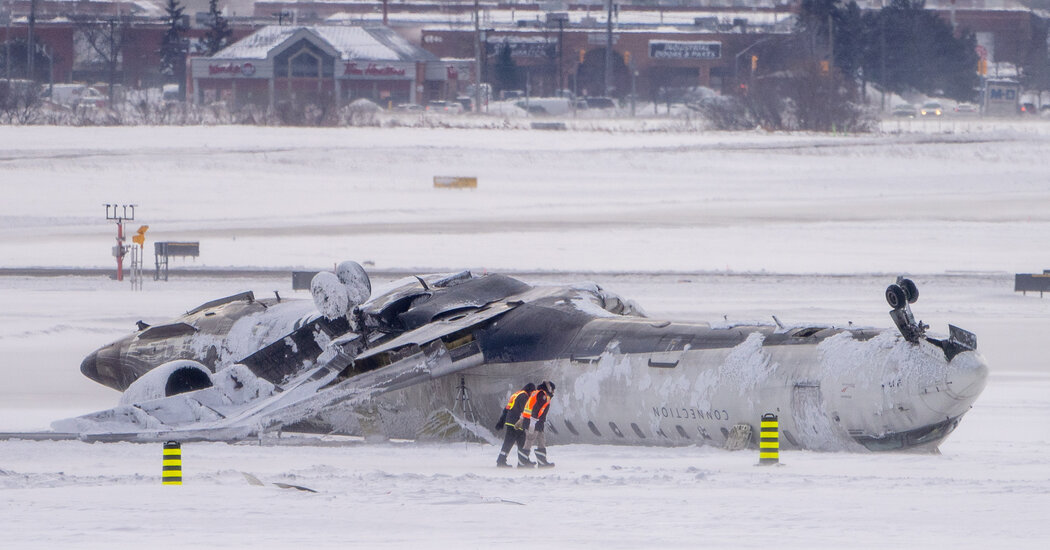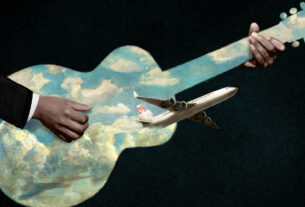A deadly midair collision involving a commercial airplane and an army helicopter. Multiple crashes in various countries. Planes catching on fire and even flipping upside down.
Over the last two months, global commercial air travel has been rocked by more than a half dozen unusual accidents that have raised concerns about the state of aviation safety. And in the United States, this comes amid an alarming number of near-misses and continued concerns about adequate air traffic control staffing.
With each incident, video footage circulates near instantaneously and widely online, traumatizing more travelers, who say that the recent spate of airplane incidents has amplified their flight anxieties. Jaimee Rindy, a 28-year-old who lives in Atlanta, said she developed a fear of flying a few years ago. This feeling has grown more intense in recent months, she said.
“It’s difficult to feel safe when you’re completely out of control and when you really have no sense of what’s happening while you’re in the aircraft,” Ms. Rindy said. “Ultimately, that’s the scariest part of being a passenger. It’s that loss of trust in the industry.”
Is flying getting more dangerous? And what, if anything, can passengers actually do to stay safer during an emergency? We consulted several experts to learn more.
The recent incidents, which are still being investigated, span different countries and types of airplanes.
Over the last two months, deadly crashes have occurred in South Korea, the United States, and Azerbaijan. In the United States, some incidents involved commercial airplanes, while others were on smaller private planes subject to less stringent safety requirements. Of all aircraft, large commercial airplanes are required to meet the strictest safety regulations.
Not all incidents were fatal. All 80 people aboard a Delta Air Lines flight that crash-landed at Toronto Pearson International Airport on Monday afternoon survived, even after the plane flipped upside down on the tarmac, with its right wing and tail shorn off.
Jeff Guzzetti, a former accident investigator for the Federal Aviation Administration and National Transportation Safety Board, said it was too early to determine the common factors connecting the recent accidents involving U.S. carriers, which included the midair collision at Reagan National Airport on Jan. 29 and the crash of a 10-person commuter plane in Alaska on Feb. 6. “Myriad issues,” including weather and F.A.A. policies, were involved, he said.
Flying remains the safest mode of transportation.
Experts stressed that flying is by far the safest form of travel.
Arnold Barnett, a professor of statistics at the MIT Sloan School of Management, said the risk of dying on a flight is close to zero. The high-profile accidents of late are a coincidence, he said.
“Twelve million people board planes every day, on average, each year,” Mr. Barnett added. “The overwhelming majority of days not a single passenger is injured let alone killed.”
The lifetime odds of dying in a car crash are about 1 in 95, according to the National Safety Council.
But the recent accidents should prompt careful analysis and vigilance about “potential deficiencies in the system,” Mr. Guzzetti said. The D.C. collision was the deadliest accident involving a U.S. airline to occur in more than a decade.
Whether safety in commercial aviation is degrading is a possibility that needs to be considered, said Kyra Dempsey, who writes about aviation accidents in a blog, Admiral Cloudberg. She added that F.A.A. cuts are a factor to monitor.
The most important safety tip? Wear your seatbelt at all times.
Experts recommend wearing your safety belt throughout the entire flight. Listening to the safety briefings delivered by flight attendants is another critical precaution, said Sara Nelson, the president of the Association of Flight Attendants-C.W. A., which represents nearly 55,000 flight attendants at 20 airlines.
Flight attendants train annually in emergency response procedures, Ms. Nelson added. This includes everything from handling unruly passengers to in-cabin fires to water evacuations.
There really may not be a safest part of the plane to sit in.
John Cox, a former airline pilot who runs a safety consulting firm, said the research has been inconclusive on whether there is a safest section of a plane. Some travelers believe it’s the back, because of the way it absorbs energy during a crash, minimizing injury to passengers, but both Mr. Cox and Mr. Guzzetti dismissed this notion.
“It just depends on the crash dynamics,” Mr. Cox said. “Don’t worry about where you sit.”
Travelers can’t predict what kind of accidents they might be in. But to avoid turbulence, Mr. Cox recommends sitting “over the middle of the wing.”
Consider purchasing a seat for your child and placing them in a car seat.
Many airlines generally allow parents to hold children under 2 on their laps instead of purchasing a seat for the child. However, both the F.A.A. and N.T.S.B. recommend against this practice, instead encouraging parents to use an approved child restraint system. Unrestrained lap children can go flying out of a parent’s arms during an emergency, such as severe turbulence, and are more prone to getting injured than children that aren’t in laps, according to a 2019 study by the National Institutes of Health.
Follow New York Times Travel on Instagram and sign up for our Travel Dispatch newsletter to get expert tips on traveling smarter and inspiration for your next vacation. Dreaming up a future getaway or just armchair traveling? Check out our 52 Places to Go in 2025.





